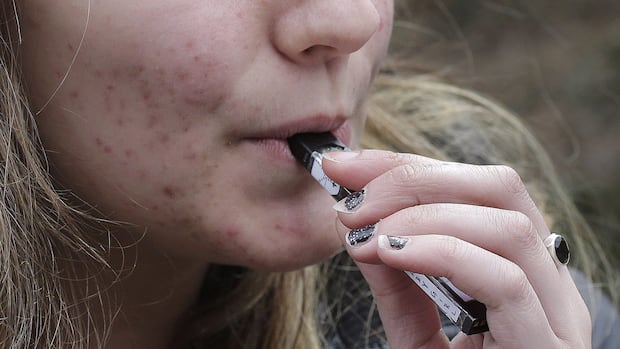A greater proportion of young New Brunswickers make poor choices for their mental and physical health than youth in the rest of Canada, according to the latest results of a New Brunswick Health Council survey.The electronic survey asked students from grades six to 12 in 33 communities about some daily health habits.Questions included how much sleep they got on school nights, how much time they spent on their phones and how much they exercised.New Brunswick scored below the national average in all three.”It’s about a percentage of our youth that may be going through some challenging times,” Stéphane Robichaud, CEO of the council, said. “When we know more about that reality, there are things that can be done.”WATCH | N.B. youth below national average in getting enough sleep, exercise: Screen time and substance use: What are the health habits of N.B.’s young people?The New Brunswick Health Council surveyed students between grades 6-12 in 33 communities across the province to find out more about how young people are using substances, exercising, sleeping and spending time on their phones.The survey also asked about substance use, and revealed that 11,000 teens use one or more substances, some of them daily.The results across the board vary greatly by region, Robichaud said, which emphasizes a need for a response on a case-by-case basis, as opposed to a blanket approach in policy and programs.”These numbers are helping various communities to perhaps have a sense of how they compare to others, but also what could be some of those barriers that youth are facing,” Robichaud said.88 per cent spend too much time looking at a screenOnly 12 per cent of youth who responded to the survey followed the national guidelines of limiting recreational screen time to two hours or less a day.The national average was 19 per cent.Robichaud said the use of screens has evolved significantly since the council started measuring the habit in 2012.”I don’t think anyone today has a really strong grasp of the extent to which screen time now has an impact because of the use of multiple mobile devices,” he said.Stéphane Robichaud, CEO of the New Brunswick Health Council, says policies to help youth make healthier choices are more sustainable at a municipal level, than at the provincial level. (Katelin Belliveau/CBC)”Time spent on screen means it’s time that’s not spent in other types of social activities, sporting activities.”The Hillsborough area had the lowest sleep score in the province, with only six per cent limiting screen time. Youth in New Maryland reported the highest percentage, with 17 per cent keeping below two hours.More than three-quarters don’t get enough physical activityThe amount of exercise youths should get in a day is 60 minutes, but only 24 per cent of young New Brunswickers are attaining that goal, according to the survey results.It’s a significant gap from the national average of 45 per cent.The community that reported the lowest amount of physical activity among youth was the Shippagan area, where only 18 per cent met the standard.New Maryland reported the highest scores in this category, as well. Thirty-two per cent meet the exercise guidelines there.40 per cent don’t get enough sleep, but numbers are betterSixty-one percent of youth reported getting the eight hours of sleep they should be getting on a school night, which is on par with the national average of 62 per cent.This category did see improvement from last year’s results, when only 55 per cent reported getting enough rest.Results for this habit also vary across the province. The Minto area reported the lowest percentage, with 51 per cent getting enough sleep. Youth in Dieppe and Memramcook reported the highest percentage, with three-quarters getting eight hours in those areas.1 in 5 reports cannabis, cigarettes, vapes or alcohol useOverall, 11,000 youth who responded, or 21 per cent, reported using at least one substance in their day-to-day life.The survey asked them about cigarettes, vaping, cannabis starting in Grade 6. It only asked about alcohol, however, starting in Grade 7.Youth reported drinking more than using any other substance the survey asked about.Sixteen per cent, or seven thousand respondents, said they drink alcohol at least once a month. Use peaks in the Kedgwick area, where 35 per cent reported using alcohol, compared to only eight per cent in Moncton.As for vaping, 12 per cent, or about 6,000 respondents across the province said they vape every day or on occasion. The percentage of youth reporting this substance use has been slowly decreasing over the past few years, according to previous surveys. Survey of N.B. youth suggests their mental health has improved Eleven per cent reported smoking cannabis in the last year. Perth-Andover had the highest percentage of youth reporting cannabis usage at 26 per cent, while the Caraquet area reported the lowest at five per cent.Cigarettes were the least common substance, with six per cent in the province reporting they smoke them daily or occasionally. Youth in Perth-Andover reported the highest percentage of smoking cigarettes, too, at 14 per cent, while only three per cent reported smoking them in Dieppe and Memramcook.”Each of these small percentages are still very important because these are sort of go-to behaviours for youth,” Robichaud said. “It’s sort of a signal of asking for help.”Robichaud said it’s valuable to track substance use as early as possible, to address bad habits before they worsen.”What we’re seeing is between, let’s say Grade 7 to Grade 12, what may be three per cent of youth vaping can grow to 12 or 18 per cent,” Robichaud said about some regions. “So there’s something happening during those years that we need to pay attention to.”Robichaud said it’s important for communities to use this information to their advantage because most of the time, local governments and groups make the most lasting change for youth in their own area.”Governments can change every four years, the leadership of our schools and school districts, they change,” Robichaud said.”It’s about continuing to learn how to better use these types of measurements but also the element of consistency over time. Hopefully, we’ll come to a point in time where we’ll see those small percentages diminish even more.”
N.B. youth make poor health choices compared to the rest of Canada, survey finds










